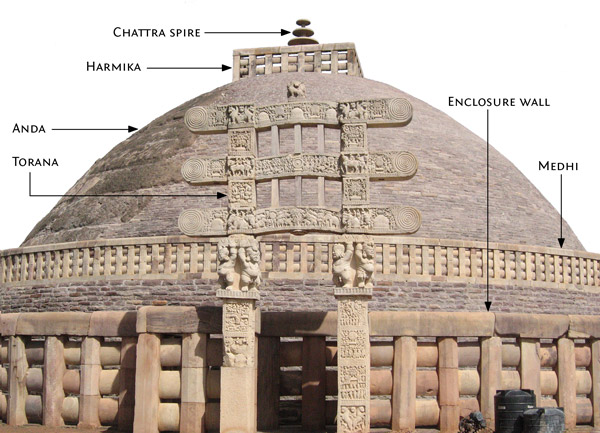Stupas are Buddhist memorial structures that typically contain sacramental artifacts connected to the Buddha or other holy figures. The stupa architecture is distinctive and has a few key characteristics, which are discussed below:
- Hemispherical shape: The stupa’s hemispherical form is thought to have been inspired by pre-Buddhist Indian burial mounds. The form stands for both the cosmos and the way to enlightenment.
- The stupa is made up of a circular base that holds an enormous solid dome (the anda, “egg,” or garbha, “womb”) from which an umbrella protrudes. The lotus flower, which is a representation of purity, is represented by the circular base.
- Circumambulatory path: A wooden railing surrounds a pradakshina walkway (circumambulatory path) that is capped by the stupa. The path is used as part of worship when people circle the monument in a clockwise direction.
- The stupa’s core was made of unburned brick, and its exterior was made of burnt brick that was covered in a thick layer of plaster. The foundation of the temple was made up of Buddha relics, such as his physical remains and tools.
- Votive stupas are built to honor or remember individuals or historical events. They are used as votive offerings and are smaller in size.
- Karmic benefits: Stupa construction offers karmic advantages. Karma has an impact on a person’s subsequent life or rebirth. The Avadana Sutra, for instance, lists ten benefits of erecting a stupa. One claims that if a practitioner constructs a stupa, he or she won’t experience extreme poverty and remote rebirth.
- Stupas were intricately designed in the first century, with features like sculptural and the enclosing of the circumambulatory path with railings. The large stupa at Sanchi was built during the reign of Ashoka out of bricks, covered in stone, and added to numerous times.
In conclusion, there are a few distinguishing characteristics of stupa architecture, including their hemispherical shape, circular bases, circumambulatory paths, core compositions, votive stupas, karmic advantages, and intricate designs. These characteristics stand for the cosmos, the way to enlightenment, the lotus flower, and purity.

